|
Richard Wagner happened to be at the world premiere of Giselle, in Paris, 1841. He didn't care for the Wilis, he reported in the Dresdner Abendzeitung on July 6, 1841, "the brides-to-be who die with unfulfilled longings for love and ascend from their graves at midnight to force the men who approach them to dance themselves to death." The legend had been introduced by the German poet Heinrich Heine in a text called "Elementary Spirits" (1837), describing the Wilis as elf-like, beautiful women in their wedding dresses, with snow-white faces, who "cannot be quiet in their graves; in their dead hearts, dead feet, remains the desire for dancing which they could not satisfy in their lifetime." Filled with "secret lust and promise, these dead bacchantes are irresistible."
This irresistible proposition was taken up by French author Théophile Gautier in collaboration with a librettist, a choreographer and a ballet master. A story evolved: an innocent village girl in love with a disguised aristocrat is betrayed, goes mad and kills herself. As a Wili, however, she forgives the now regretful rogue and saves him from his certain death. What a story! Innocence, seduction, deceit, revenge, forgiveness, redemption. The romantic interest in the supernatural made this legend of frustrated, ghostly brides and sexual sublimation an instant triumph. Giselle became the romantic ballet par excellence, a worthy successor to the first "elfine" ballet, La Sylphide, from 1832.
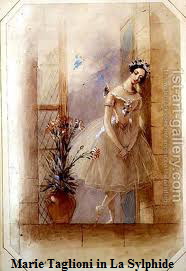 It did not matter that the music by French composer Adolphe Adam (written in just a few days) is mediocre. Parts of the first village act sound like the "rom-pom-pom" for a marching troop of soldiers rather than for merry peasant dances. Sitting through Act I can be an ordeal if one is not in luck with a great cast. Wagner particularly loathed the composer, characterizing him as someone who "shamefully quickly exhausted his inspiration and composed himself to death almost as quickly as the victim of the Wilis dances himself to death." He has a point. But there are charming passages when Giselle is dancing with her paramour Albrecht, inserts by later composers, and things get better and dramatically tighter in Act II, in the forest of dead brides who are so otherworldly that they hardly touch the ground, and yet are implacable in their fury. It did not matter that the music by French composer Adolphe Adam (written in just a few days) is mediocre. Parts of the first village act sound like the "rom-pom-pom" for a marching troop of soldiers rather than for merry peasant dances. Sitting through Act I can be an ordeal if one is not in luck with a great cast. Wagner particularly loathed the composer, characterizing him as someone who "shamefully quickly exhausted his inspiration and composed himself to death almost as quickly as the victim of the Wilis dances himself to death." He has a point. But there are charming passages when Giselle is dancing with her paramour Albrecht, inserts by later composers, and things get better and dramatically tighter in Act II, in the forest of dead brides who are so otherworldly that they hardly touch the ground, and yet are implacable in their fury.
The notion that feminine forgiveness trumps all evil and even death, inspired the great choreographer Marius Petipa to whom we owe Swan Lake, Sleeping Beauty, Nutcracker and many more of 19th century staples. Petipa took Giselle in hand in 1862, and today it still larglely shows his hand, exerting its power and making Giselle the most frequently performed of all classical ballets. Balanchine explained the phenomenon: "Like Hamlet, Giselle is a classic: it is not only important historically, it also happens to be good (…) People go to see Giselle and to see ballerinas dance it for the same reason we go to see new interpretations of Hamlet: the work is such a good one that we always discover something in it we hadn't seen before…"
What Balanchine doesn't say here is that dancing and acting the role of Giselle is as hard as acting Hamlet, and a success is equally unlikely. Technically, it is one of the most demanding parts, a bravura act performed against the laws of gravity. Portraying the contrast between a girl's shy, fragile opening to love, her breakdown in suicidal madness, the lightness of an immaterial spirit and the gravitas of a compassionate soul, is much harder to pull off than even the demanding dual roles of the White and Black Swan (Odette and Odile) in Swan Lake. The potential rewards, however, measure up: A superb performer can raise Giselle out of romantic sentimentality into the sublime sphere that Goethe evokes at the end of Faust: "The eternal feminine calls us to a higher realm."
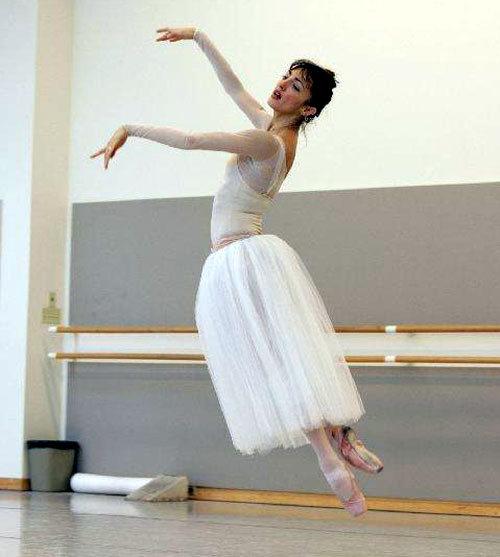 |
Like any ballet aficionada, I am fiercely biased. I do not attend Giselle unless I sense I will see a master at work. My luck is that San Francisco Ballet hosts one of the greatest Giselles of our time, Cuban star Lorena Feijoo who wears the shoes of the great Giselles who came before her. Luck had it that she again performed Giselle this year.
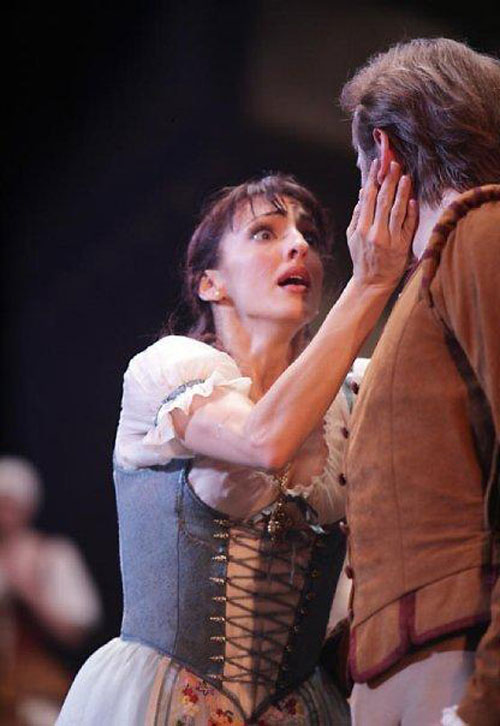 |
Dance critic and author Ocatvio Roca remembered, at the end of 2002, in the San Francisco Chronicle column "Top Dance Events": "…one memory stands out and will stay with me for years to come: Lorena Feijoo dancing the title role in the opening of last spring's San Francisco Ballet revival of Giselle. She was exquisitely heartbreaking, and she meant every step. There was hope in the teasing balances of her entrance, then later, a frenzy of horror and grief in the monumental tragedy of her mad scene. Like her mentor Alicia Alonso, Feijoo is a powerful classical ballerina who has willed herself into the romantic mold. From the sensual line of her neck and the presentational thrust of her torso, from the crystalline articulation of her steps to the seamless and breezy way she put these steps together, Feijoo's was a devastating interpretation of what is perhaps the richest role in ballet. She was simply unforgettable."
Nine years later, the artistic maturity of Lorena Feijoo's Giselle left me in plain wonder the first night she danced the role, and speechless the second (her last for this season). Seeing her twice was an interesting lesson in degrees of perfection. The first night, her partner, Vitor Luiz, freshly imported from Brazil, was visibly nervous, taking on the role of Albrecht for the first time. He flunked a landing here, a pirouette there, unable to hold his own against the powerhouse Feijoo. As happens so often in her case, the male dancer is not her match and she has to do it all more or less on her own. There's a limit to perfection, even at the top.
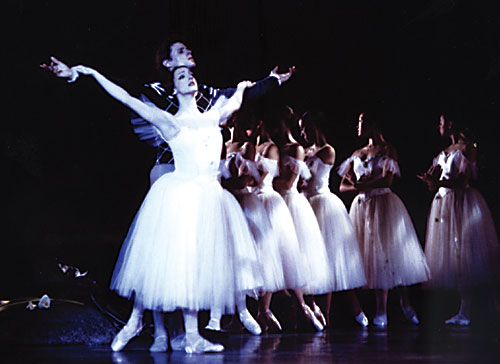 |
But the second night, Luiz was confident and Feijoo was able to dance with every fiber, no holds barred, in the kind of high-risk performance she is famous for. Everything worked for her, every pirouette was stunning, every balance "unreal." The mere technical ease and fluidity of her dancing were astounding. To give one example: when the dead girl's spirit is called forth for the first time by Myrtha, Queen of the Wilis, and ordered to dance, Giselle starts with the movement called (among ballettomanes) "exit from the grave." She spins backwards on one leg with little flat-footed hops, the other leg lifted in the bent-knee arabesque position called "attitude", and after several turns she suddenly flies up into a double pirouette on point, both arms raised, as if lifted by an invisible current of emotion. Nobody else at San Francisco Ballet dares to perform this virtuosic, thrilling move. You can watch it on YouTube http://www.youtube.com/watch?v=-0vOzLQai9M&feature=related (and, if you like, compare it with her equally brilliant younger sister Lorna Feijoo, who does it, too, both having been trained in Cuba.) Then go down the list to the major present star of the Bolshoi, Natalia Osipova, and watch her "exit from the grave". Osipova is faster; she does the turns on demi-pointe, which allows for speed, but there is no double pirouette to thrill you. Go on to compare the steps that come next: the diagonal of little leaps that take the dancer across the entire stage – a movement meant to establish that now Giselle is a spirit, not made from flesh and blood, not bound by gravity any longer. Osipova is famous for her lightness and the height of her leaps, but she hikes herself up with her arms every time she takes off. None of this in Feijoo's diagonal. Her arms perform an exquisite downward curve instead of going up, and typically for her way of dancing, her arms and hands live their seemingly independent, mysterious life.
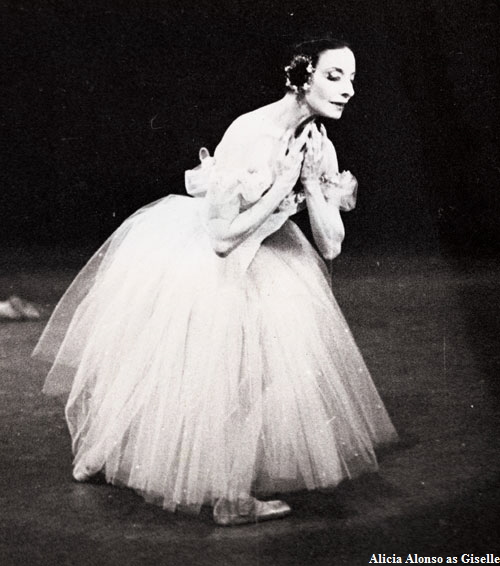 |
Then add to this technical marvel what is being expressed in the dance. The story Feijoo tells in Act II is so much more than the sad good-bye of a dead girl to her lover, pleading with her Wili sisters to spare him. Seeing Feijoo, one witnesses an aching separation from the material world, the body, sensual love. She dances the mourning for a young lost life and the supreme effort, the soul's longing, to break through the veil of death and reach the lover, touch him, love him one last time, for all eternity. In the words of Jennifer Homans' excellent book on ballet, Apollo's Angels (see review by Catherine Honig in Scene4), "There was a strain of utopianism in this: La Sylphide and Giselle held out the alluring 'if only' promise of a balletic Elysian paradise of happiness and true love. But the point, of course, was the impossibility of ever getting there. What mattered for the French Romantics was the aestheticized sense of loss – the intense feeling of yearning. "
Feijoo seems to channel the spirit of the great Giselles of the past even in her physicality, by melting into the romantic posture you see in the early engravings of Marie Taglioni (who created La Sylphide), 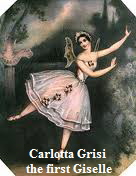 Carlotta Grisi (the first Giselle), Olga Spessivtseva (who reintroduced Giselle to Paris audiences in 1924), to Galina Ulanova, Yvette Chauviré and onward to her own teacher, Alicia Alonso. She takes on the slightly forward-curving back-and-neck line, rounded in an expression of yearning and at the same time of humility and selflessness that make Giselle's forgiveness poignant and believable. Such artful stylistic shape-shifting seems natural to her and one is transported, not quite knowing how to explain it or even how to locate the experience: the present moment seems to be of the past, pulling one into the presence of an archetype. Her exquisite feet, her cloud-like landings, the way her feet slightly trail behind her body in the lifts, make her appear as if she were a feather carried in a breeze. And her lyrical phrasing lifts everything with her; she seems to even raise the music itself into the air. Seeing Adolphe Adam's composition so thoroughly transcended by the dance gave the impression that something uncanny, indeed supernatural, was happening here. Call it art. Or name it with the words of German mystic Hildegard von Bingen, "a feather on the breath of God." Carlotta Grisi (the first Giselle), Olga Spessivtseva (who reintroduced Giselle to Paris audiences in 1924), to Galina Ulanova, Yvette Chauviré and onward to her own teacher, Alicia Alonso. She takes on the slightly forward-curving back-and-neck line, rounded in an expression of yearning and at the same time of humility and selflessness that make Giselle's forgiveness poignant and believable. Such artful stylistic shape-shifting seems natural to her and one is transported, not quite knowing how to explain it or even how to locate the experience: the present moment seems to be of the past, pulling one into the presence of an archetype. Her exquisite feet, her cloud-like landings, the way her feet slightly trail behind her body in the lifts, make her appear as if she were a feather carried in a breeze. And her lyrical phrasing lifts everything with her; she seems to even raise the music itself into the air. Seeing Adolphe Adam's composition so thoroughly transcended by the dance gave the impression that something uncanny, indeed supernatural, was happening here. Call it art. Or name it with the words of German mystic Hildegard von Bingen, "a feather on the breath of God."
The magical perfection of this performance (even San Francisco Ballet director Helgi Tomasson felt he had never seen Feijoo dance better) could not have happened without the beautifully timed, sensitive partnering of Vitor Luiz. With confidence gained, he cast a young and noble figure, with elegant leaps and thrilling back-bend grand-jetés. In terms of emotional and acting expression he still has to mature, but when his Albrecht was close to exhausting himself to death, his final long series of high entrechat leaps had a quality of despair that made the audience cry out for him.
Beautiful Elena Altman added the spice of filigrane classical purity of line and lyrical phrasing to the Queen of the Wilis. The corps, like in last season's remarkable Swan Lake , showed impeccable unity of style and grace to uphold the enchantment of the fairy tale.
In shocking disregard of what was undoubtedly the high point of the season, San Francisco Ballet was unable to provide a single photograph of the event. All photos shown of Feijoo are from the past; her partners are Yuri Possokhov and Vadim Solomakha. (Archival photos by Erik Tomasson)
An Aside: Anti-Climactic Black Swan at the Opening Gala
The Opening Gala of the season delivered a surprise, not announced in the program: the ad hoc addition of the Black Swan Pas de Deux from Swan Lake, with Sofiane Sylve and Vito Mazzeo, presumably intended as a commentary on the general excitement over Black Swan, the Oscar-nominated movie. From inside the world of classical ballet, one would of course expect sarcastic comments on the easy, cheap thrills of Aronofsky's film and Natalie Portman's would-be ballerina (see my review). But letting Sofiane Sylve, a dancer gifted for cool, languorous movements without edges, defend the virtues of true stage virtuosity and art in the role of the Black Swan (Odile) fizzled like a wet fire-cracker. If you needed an antidote to Natalie Portman's portrayal, which earned her the Oscar for Best Actress, here it was: served with little passion, personality, acting — a lukewarm dish without spice.
|
|

